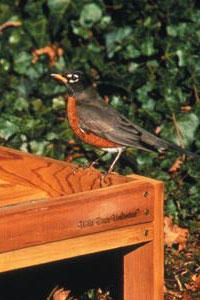Fun Facts About The American Robin
Find out more about a frequently seen bird about town.

- The quintessential early bird, American Robins are common sights on lawns across North America, where you often see them tugging earthworms out of the ground. Robins are popular birds for their warm orange breast, cheery song, and early appearance at the end of winter. Though they’re familiar town and city birds, American Robins are at home in wilder areas, too, including mountain forests and Alaskan wilderness.
- American Robins eat large numbers of both invertebrates and fruit. Particularly in spring and summer they eat large numbers of earthworms as well as insects and some snails. (They have rarely been recorded eating shrews, small snakes, and aquatic insects.) Robins also eat an enormous variety of fruits, including chokecherries, hawthorn, dogwood, and sumac fruits, and juniper berries. One study suggested that robins may try to round out their diet by selectively eating fruits that have bugs in them.
- Female robins choose the nest sites, which are typically on one or several horizontal branches hidden in or just below a layer of dense leaves. Nests are typically in the lower half of a tree, although they can be built as high as the treetop. American Robins also nest in gutters, eaves, on outdoor light fixtures, and other structures.
An American Robin can produce three successful broods in one year. On average, though, only 40 percent of nests successfully produce young. Only 25 percent of those fledged young survive to November. From that point on, about half of the robins alive in any year will make it to the next. - When foraging on the ground, the American Robin runs a few steps, then stops abruptly. In long grass, robins may hop or fly just above the ground powered by slow, powerful wingbeats. American Robins often find worms by staring, motionless, at the ground with the head cocked to one side. Robins sometimes fight over worms that others have caught. During fall and winter robins often roost in large flocks and spend much more time in trees. In spring, males attract females by singing, raising and spreading their tails, shaking their wings and inflating their white-striped throats. When pairs are forming in spring, you may see a display in which a male and female approach each other holding their bills wide open and touching them. American Robins are strong, straight, and fast fliers.
- The oldest recorded American Robin was 13 years and 11 months old.

